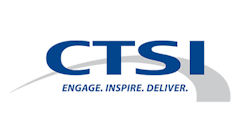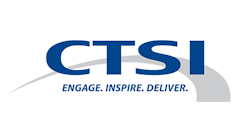This article originally appeared in the March 2022 issue of Security Business magazine. When sharing, don’t forget to mention Security Business magazine on LinkedIn and @SecBusinessMag on Twitter.
When industry veteran Joe Oliveri stepped into the role of president and CEO of Corbett Technology Solutions Inc. (CTSI), in May 2021, he joined a company with ambitious expansion plans – one poised to undertake a dizzying acquisition spree intended to further enlarge its already global footprint.
As of this writing, and going back to February 2021, CTSI has picked up eight companies so far, with plans to acquire three more perHeadquartered in Chantilly, Va., CTSI integrates under its umbrella all manner of technology and services innovation, with its portfolio comprised of fire, security, critical communications, collaboration, IT and audio/visual solutions, says Alan Rosenkoff, VP – BD, Communications & Corporate Marketing.
CTSI provides services including design, installation, integration, managed, subscription, and central monitoring, offering them to government, healthcare, education and enterprise customers worldwide.
Prior to his arrival, Oliveri most recently served as VP and GM of Global Ducted Systems for Johnson Controls. During his 25-year tenure with the company, Oliveri was tasked at various times with running“Several were $2 billion businesses,” Oliveri recalls. “I had the opportunity to run a national platform and also understand how to scale a small business into a large business. Additionally, my background in fire, security and low-voltage aligns with CTSI’s low-voltage expansion plans.”
Facilitating these plans is CTSI’s relationship with Wind Point Partners, a Chicago-based private equity firm. Wind Point acquired CTSI in 2020, providing the fuel behind the company’s growth strategy.
Oliveri describes Wind Point as “extremely supportive.” As an example, he cites CTSI’s September 2021 acquisition of AFA protective Systems Inc. – a process that took a mere three months from start to finish, an almost unheard-of pace.
Moving quickly and decisively is important, says Oliveri, particularly given the scope the company’s intentions. “No other private equity firm would be as fast,” Oliveri says. “Wind Point is integral to our growth plans. They have allowed us to be flexible and creative when it comes to putting deals together.”
Making the Cut
The criteria for the businesses CTSI considers for onboarding is exacting.
“CTSI acquires successful businesses that enable our growth by expanding geographic coverage, enhancing technical capacity and services portfolio capabilities, while remaining focused on the customer experience,” Rosenkoff explains.
Those making the cut so far include a veritable who’s who of well-established fire and security integration companies, including AFA Protective Systems, a company with security roots dating back to 1873.
Each of these companies (see the timeline below) aligns with CTSI’s desire to build out its three lines of business – fire solutions, integrated security/cyber solutions, and AV and critical communication solutions – and to enlarge its reach.
Earlier 2021 acquisitions DavEd Fire Systems provides fire alarm and security systems, as does AFA, while CTS delivers AV, security and additional low voltage/highly engineered solutions. The Protection Bureau offers integration, service and central station monitoring of enterprise burglar and fire alarms, as well as video and access control systems.
Early 2022 acquisitions Systems Electronics, an integrator of communications, safety and security systems, will help expand CTSI’s healthcare, fire and security capabilities; while Structure Works, which engages with enterprise customers and specializes in enterprise account turnkey solutions, brings project management and other support to CTSI’s security integration platform.
Acquired Brands Retain their Identities
One strong selling point that makes CTSI more attractive to its acquisition targets is that rather than breaking them up, CTSI grows the existing business instead – not difficult to do, since companies they have purchased have a track record as “very viable leaders in their space,” Oliveri says.
The acquisitions retain managerial autonomy, although they do have required performance targets, and they all must be on CTSI’s system. But maintaining the culture, legacy and brand value of those companies is important, Rosenkoff says. Although each of them is different, there are commonalities in the sense of having happy employees and being customer focused.
Many of these companies did not have “scale,” Oliveri explains, and so as CTSI scales them up, it has also ramped up hiring to meet the expanded need. As a result, CTSI now employs more than 1,200 people and generates in excess of $400 million in annual revenue, Rosenkoff says, adding that the company currently has 50 locations in the U.S. and 30 locations internationally.
“The acquisition engine is showing no signs of slowing,” Rosenkoff says. “Additional acquisitions are planned for Q1 of 2022 and more are being worked for Q2 and beyond.”
Bringing it Together
CTSI has always been a diverse company, but thanks to its acquisitions, it has become even more so, since the acquired companies were already diverse themselves, Oliveri says.
The value of diversity is that it leads to better decision-making, Oliveri says, adding that “a cross-section of perspectives gets us to the right answer or to the best answer.”
CTSI has taken steps to avoid one of the risks of expansion – that cohesiveness and communication can be negatively impacted. As they have grown, Oliveri explains that their communication strategies have had to evolve, which led to the formation of the CTSI ClearTalk Internal Series.
Consisting of pre-recorded videos directed to the CTSI executive team, the intent is to help the team communicate status updates and areas of focus to all employees. Other strategies include an internal newsletter distributed every three weeks; launching a new corporate intranet; and giving all executives the ability to record and send videos via email and/or text to specified audiences.
There is also a ClearTalk Video Podcast Series. “[The podcast is] customer-focused, demonstrating CTSI thought leadership,” Rosenkoff explains. “The next issue to be released includes David Kleinman, president of our Fire Solutions LOB, and Mark Labua, CIO, discussing the history of AFA and theOliveri adds that maintaining CTSI’s company culture and values is critical. “We try to be flexible and work with people on their situations,” he says. “It is important to say thanks. It is about appreciating the employee base and also creating an environment where people are not afraid to make mistakes. We want people to be decisive and to make decisions.”
Because the companies CTSI has acquired all have existing relationships and capabilities, CTSI is able to share them with its customers, further juicing its growth strategy, Oliveri says.
Managed and Subscription Services
Offering subscription services has also enabled CTSI more RMR opportunities, he adds, describing the service as a “very good growth lever” for CTSI and its acquired companies.
Launched at the end of 2018, subscriptions are available in 36-, 48- and 60-month terms, based on customers’ preferred technology refresh cycles. Everything CTSI delivers and markets is available by subscription, Rosenkoff explains.
“At the end of the initial term, customers may implement a complete technology refresh to keep their technology current,” Rosenkoff says. “A subscription includes hardware, software installation and ongoing maintenance, management and monitoring for a fixed monthly fee at a lower TCO than a standard capital purchase.”
Although this is a new concept for some of the companies they have acquired, Oliveri and Rosenkoff are seeing adoption “across all technology pillars,” with Rosenkoff adding that subscriber growth is greater than 100 percent year over year.
Adoption has been fueled by the multiple advantages the service offers, such as helping the acquired companies differentiate themselves from their competitors and making technology more accessible to their customers – transforming this from a capital to an operational expense, and keeping them current.
Cybersecurity is a critical element of the subscription package, Rosenkoff adds, explaining there are several options available, such as offering it as a stand-alone service, or incorporating it into the existing subscription package – which can be done “almost instantaneously.”
Regardless, the cybersecurity package could have different “bundles” derived from an assessment, followed by a review of findings, recommendations and then implementation based on those findings.
Rosenkoff says this approach enables CTSI to offer a tailored, personalized solution, since every customer will have different security needs. Just as is the case with IT subscription services, the cybersecurity component provides refresh cycles, offering the advantage of enhanced cybersecurity through ongoing software updates, Oliveri adds.
The Future
CTSI’s active M&A strategy is just the tip of the iceberg for the industry as a whole. Oliveri says he anticipates more consolidation as companies look to create a national footprint.
“Integration affords greater scale – for example, in technical and engineering manpower,” he says. “The biggest thing we face today is getting bodies. Integration also gives companies more power with suppliers, as they are more apt to pay attention to their larger customers.”
Pamela Mills-Senn is a freelance writer based in California. Learn more about her at www.pamelamills-senn.com.










